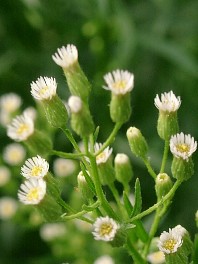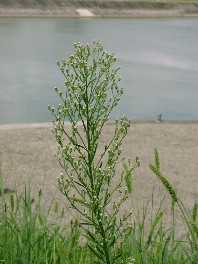 The Butterweed is a plant that is about one meter (three feet) high.
Originally it is at home in northern America.
Since the 17th century it has spread around the world, especially in Europe.
The Butterweed is a plant that is about one meter (three feet) high.
Originally it is at home in northern America.
Since the 17th century it has spread around the world, especially in Europe.
The flowers of the Butterweed are very small, therefore they are not seen as beautiful. Inspite of its size the Butterweed is noticed very seldom.
The Butterweed can help against diarrhea and bleedings. You can also use it against problems of women.
Medicinal Uses
- Astringent
- Stops bleeding
- Diuretic
- strengthening
- Diarrhea
- Dysentery
- Haemorrhoids
- Haemorrhoids bleedings
- Rheumatism
- Gout
- Blood sugar sinking
- Menses forcing
- Menopause complaints
- Mouth inflammations
- Gingivitises
- Nosebleed
Information
| Used Parts: | Plant |
| Other Names: | Canadian Fleabane, Horseweed, Coltstail |
| Substances: | Essential oils, tannic essence, tannic acid |
| Time to collect: | June until October |
Methods
 The Butterweed can be used as a tea.
The Butterweed can be used as a tea.
Use one teaspoon of the Butterweed herb an pour one cup of boiling water over it. Let it stand for ten minutes.
The main use of Butterweed is against diarrhea and other intestinal problems.
It can be used also against all kinds of bleedings, but this effect is not very strong.
For women it can help against menstrual problems, too strong bleeding or too late menstruation. It can also help after birth. In menopausal times it allays typical problems of this age.
Used regulary Butterweed can lower the blodd sugar level.
Plant description
 The Butterweed has its origin in North America.
In the 17th Century it came to Europa and has spread around the world since then.
The Butterweed has its origin in North America.
In the 17th Century it came to Europa and has spread around the world since then.
At warm and mild areas, with sandy ground the Butterweed is very common. In rough ares it is a seldom plant.
The annual Butterweed grows in late spring.
Its stems get 20 cm up to one meter, sometimes more.
The leaves are narrow and lots of them grow directly from the stem.
In July the stem branches out and gets flowers.
The flowers are very small, only 3 mm in diametre. They are white at the outside and yellow inside.
When the flowers are finished, they get brownish and wooly seeds, that can fly in the wind to spread.
